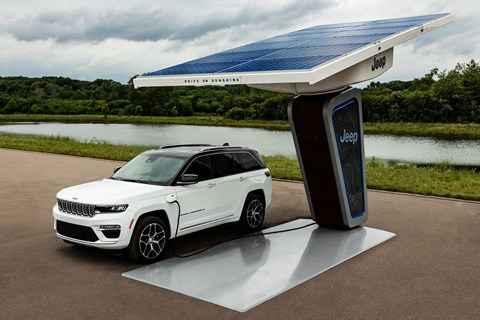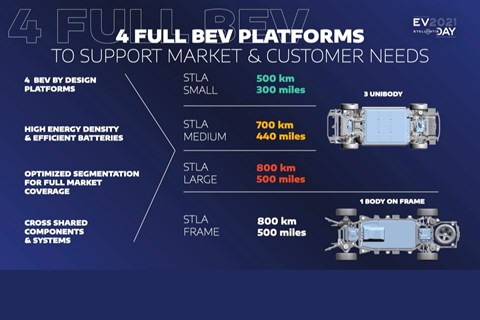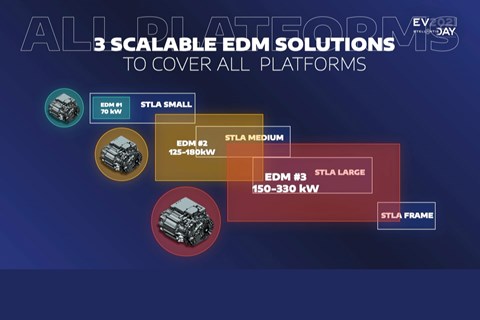► Stellantis group outlines electrification push
► All 14 car brands to use four new EV platforms
► Electric performance cars and trucks confirmed
The Stellantis mega group has announced massive plans to unify all 14 brands’ respective electrification plans, having developed four new platforms to be used in every segment from city car to full-size SUVs and trucks.
‘All 14 brands of Stellantis can enjoy the same technology, components and software,’ Stellantis boss, Carlos Tavares told the media at the EV Day conference; ‘the strategy we laid out today focuses the right amount of investment on the right technology to reach the market at the right time, ensuring that Stellantis powers the freedom of movement in the most efficient, affordable and sustainable way.’
So what are the take-aways from the massive EV Day conference? Keep reading to find out.
What did the Stellantis brands say?
Not every brand was covered during the conference, with the brands making announcements mostly coming from the former FCA Automobiles group. Perhaps this highlights the progress of electrification of the former PSA brands (Citroen, DS, etc.) is ahead of the brands that were more recently acquired when Stellantis formed.
Opel announced that 100 per cent of its current range would be electrified by 2024, and will be a pure-electric brand in Europe in 2028. The brand, which also said it would enter the Chinese market in the next few years, will also revitalise the Manta name properly as a pure-electric crossover by the middle of the decade.

Fiat‘s Olivier Francois said Fiat already made a good start with the new electric 500 and would make all its commercial vehicles have low-emission versions by 2022. What comes next is an ‘unprecedented passenger car offensive’ from the brand by 2024, hinting once again that the Centoventi concept would make a new electric car addition to the range. Abarth, too, will go all-electric in 2024 – presumably using the electric 500 as a starting point.
Dodge took a different approach, understanding its base in the North America market is mainly for performance cars. It sees electric power as the next step in delivering more power than a combustion engine can provide.
RAM, also a brand with a history of large trucks in the North American market, announced a new battery-electric 1500 truck in 2024.

Lastly, Jeep pointed out it already has the top-selling plug-in hybrid SUVs in Italy with the Renegade and Compass 4Xe, and that its new Wrangler 4Xe plug-in hybrid was the top-selling PHEV in the USA. It’s developing solar-powered chargers for remote areas in the US, so Jeep (and we suppose other 4×4 owners) can use when out exploring and has just announced a plug-in hybrid of its new Jeep Grand Cherokee. It’s not slowing down either; the brand says it will have a zero-emission Jeep in every segment by 2025.
So, how are these brands going to carry out these visions?
By using these new battery-electric platforms over the next decade. The four new platforms, all named STLA (and spoken like ‘Stella’ by executives during the EV Day conference), are named Small, Medium, Large and Frame. Each platform will be available with a range of different battery densities and electric drive module (EDM) power ratings for maximum flexibility.

Stellantis engineers and executives say the new platforms have been designed to evolve over time, and will introduce new battery innovations. A nickel-cobalt-free battery alternative is planned for 2024, and a solid-state battery pack is targeted for introduction in 2026.
STLA Small will benefit all brands that have city cars and superminis in their portfolios. This platform allows for battery capacities between 37 and 82kWh, with a range target of 300 miles. New EVs expected to use this platform include those part of Fiat’s ‘passenger car offensive’ like the Centoventi, as well as the next generation of small cars from the likes of Opel/Vauxhall, Peugeot and Citroen.
STLA Medium will be used exclusively by DS and Alfa Romeo to develop premium models ranging from saloons to SUVs, with battery densities ranging from 87 to 104kWh and targeted range of up to 440 miles. This does not affect the upcoming Alfa Romeo Tonale, which uses an FCA-derived platform that currently underpins the Jeep Rengade, Fiat Tipo and 500X.
STLA Large is for larger SUVs and mid-size trucks across the Stellantis group. With battery densities ranging between 101kWh and 118kWh, the group says models on this platform will be capable of 500 miles.
On top of these three monocoque platforms, STLA Frame is designed for the largest SUVs and pickup trucks. As the name suggests, it’s a body-on-frame platform – a design still prevalent in brands like Jeep and RAM, for example – with a battery pack inset between the structure. Again, Stellantis is targeting a maximum 500-mile range from battery capacities ranging between 159kWh and more than 200kWh.

As for the powertrains, Stellantis has announced it will use three separate electronic drive modules. EDM 1 will be 400V and put out 70kW (93bhp) per unit, making it light and handy for small city cars that don’t require much power, or around 186bhp if applied to each axle for electric all-wheel drive. EDM 2, too, is 400V and can range in power from 125kW to 180kW (164bhp to 241bhp). EDM 3 can work with either a 400V or 800V electronic architecture, delivering between 150kW and 330kW (201bhp to 443bhp).
My head’s spinning – anything else?
Stellantis is in the process of building five gigafactories across North America and Europe to cater to the huge amount of battery demands the group requires, with its strategy estimating more than 260GWh is needed by 2030.
Other targets include making 70 per cent of its sales in Europe and 40 per cent of its sales in the US to be made up of ‘low-emission vehicles’ (i.e plug-in hybrids and battery-electric cars) by 2030.
Read more CAR industry news here